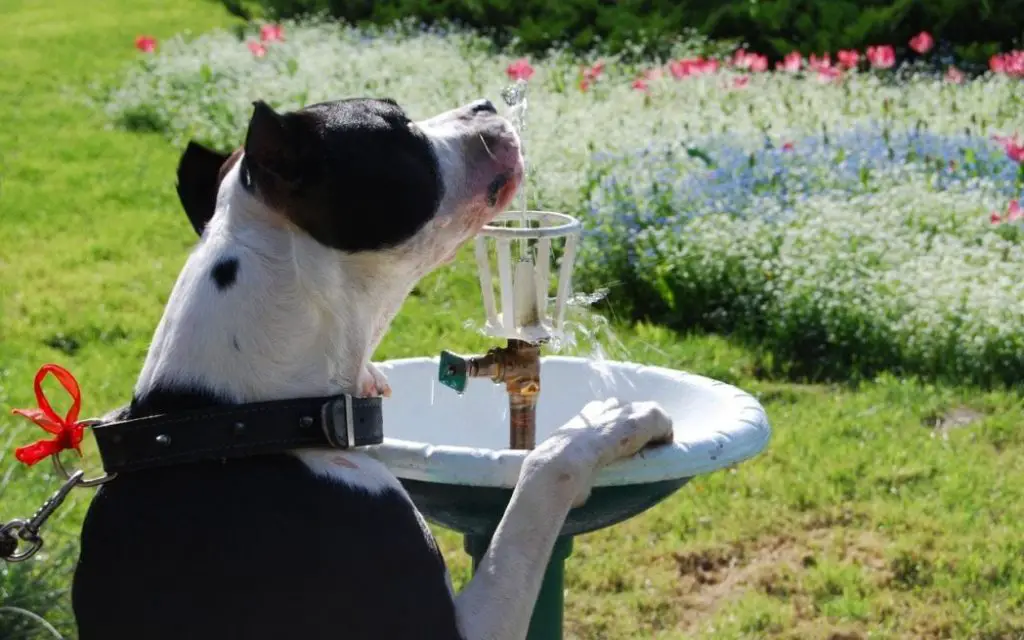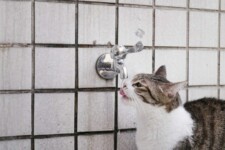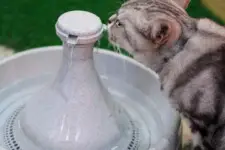How Long Can A Dog Go Without Water? (How Long Is Safe?)
For humans water is life, and it’s the same for dogs and cats also.
Realistically dogs need regular water to survive and be in good health, however there are times when your dog refuses to drink water due to a health condition or other reasons.
A dog may also fail to drink enough water simply because their water bowl was empty due to being too small, or not refilled regularly enough.
The truth is dogs cannot survive without water for long – just like us.
How Long Can A Dog Go Without Water?
Most dogs can survive up to 2-3 days without water, and can be a little higher or lower depending on the age, breed, current health condition, and climate. This would leave them severely dehydrated and at risk of serious health complications, with immediate veterinary assistance recommended.
Let’s go deeper into the topic of dog dehydration looking at the common causes and symptoms of dehydration in dogs, as well as ways to prevent dehydration in dogs.

A dog’s body comprises 80% water and 20% body mass.
A small drop in the water composition in your dog’s body will leave them dehydrated, and at a greater risk of having serious health complications that would need to be addressed immediately.
How Long Without Water Is Safe?
Generally up to 24 hours is safe if the weather isn’t too hot, and apart from being thirsty, most dogs should be fine without any ongoing physical problems. At this stage they will begin to display early signs of dehydration.
The best situation is to avoid your faithful dog being without water for long periods, as regular drinking is best for their health.
Dogs with health issues such as kidney disease may be most vulnerable and may suffer serious consequences if they go without water past the first day.
Weather conditions impact the time a dog can survive without water. During the summer dogs tend to get dehydrated more quickly than during the winter season.
Causes of Dehydration in Dogs
While a lack of access to clean drinking water is one of the causes of dog dehydration, there are other reasons why dogs may stop drinking water.
Illness
Certain illnesses such as diabetes and kidney disease may cause your best friend to stop drinking water, or take less water than their regular level of water intake.
Fluid loss from vomiting, diarrhea, and even excessive urination can make a dog dehydrated.
The fact that sick dogs feel nauseous makes the condition even worse because they do not have an urge for water.
Cold Weather
During cold weather dogs do not lose a lot of water compared to the higher temperature months of summer. As a result there is little or no urge to drink a lot of water.
In summer months dogs tend to lose a lot of water due to the high temperatures, and this forces them to drink more water to regulate body temperatures.
Aging
Dehydration tends to go hand-in-hand with the dog’s age, and older dog have a low appetite for water and food.
Older dogs tend to laze around and do not exercise as much as they did during their ‘teenage’ years. They tend to spend most of the time sleeping and this means that they have a lower urge to drink water.
Traumatic Experience
When dogs go through a traumatic experience such as an accident, dental surgery, or neutering, stress can cause them to lose the urge to drink water or even eat food.
Being In An Unfamiliar Place
If you relocate to a new house or travel with your dog to a new location, your dog may refuse to drink water or other fluids due to the unfamiliar environment.
Naturally, dogs can be cautious new environments, and they may stay away from the water bowl until they adjust to their new surroundings, or go back to a familiar place.
Signs of Dehydration in Dogs
Sometimes dog owners do not take note of evident signs of dehydration in their dogs, either due to lack of awareness or because they rarely spend time with their dogs.
Dog owners should take a keen interest in the day-to-day lifestyle of their dogs so they will notice when there is an abrupt change in their routine.
For example, they should be aware of the normal amount of water that their dog drinks each day so that they can detect changes in the dog’s drinking patterns.
Detecting early warning signs can help dog owners act quickly before the conditions become fatal.
Lethargy
Lethargy is a state of feeling sluggish, tired and fatigued.
Staying for a long time without drinking causes a drop in energy, and a usually energetic dog appears uncharacteristically fatigued.
There will be less blood flowing in the muscles, and the level of energy to fuel the muscles will drop.
Low Appetite
A dehydrated canine experiences difficulties in chewing, swallowing and even digesting food.
It is even more problematic when the main food regime is dry kibble, which can cause mouth sores and injuries.
If you see a normally insatiable dog showing disinterest in food, it could be a symptom of dehydration.

Sunken Eyes
If your dog has sunken eyes, it is possible that he is dehydrated. Sunken eyes occur due to a lack of water in the muscles that hold the eye, and in the eye itself.
- If your dog’s eyes appear sunken, you should see a veterinarian immediately.
Low Skin Elasticity
The skin of a well-hydrated dog tends to regain its shape quickly when pulled or pinched.
A dehydrated dog tends to have a low skin elasticity, and the skin takes longer to retract to its original position. This occurs due to the lack of sufficient fluid in the dog’s skin.
How to Prevent Dehydration In Dogs
Dehydration is a risky condition that can expose your dog to severe and unintended consequences. Leaving your dog dehydrated for too long can cause life-threatening illnesses and even death.
- As a responsible dog owner, you should ensure your pet has access to clean drinking water at all times, even when traveling for an extended period of time.
Here are some ways to ensure that your dog is well-hydrated:
Avoid Salty Foods
Giving your dog meals high in salt can lead to excessive thirst. If the increased thirst does not entice your dog to drink more water, then they at risk of being dehydrated.
Salty foods can result in health complications such as high blood pressure, vomiting, and even tremors.
Snacks such as popcorn and biscuits are high in salt, and they can result in dehydration if the dog does not drink enough water.
Use Canned Or Fresh Dog Food
Dehydrated foods come in handy when feeding dogs that need encouragement to drink water. This type of food is usually a high-protein food that is dried to remove moisture.
The alternative to dehydrated dog food is canned dog food. Canned food has a high moisture content to help provide more fluid to your dog.
This type of food has a better taste than dehydrated dog food and it is delicious even to picky eaters.
Carry Water During Car Travel And Walks
When going on long walks or traveling long distances, it is likely that your dog will be affected by the changing temperature and may become dehydrated.
When packing essentials for the journey remember to carry enough water to last both of you through the journey.
Make Water Available In Strategic Locations
One way of enticing your dog to drink enough water is to place refilled water bowls in a few visible areas of the house easily accessible to your dog.
If your dog likes playing in the backyard you should place another water bowl in a visible place in the garden.
- As a rule, always monitor the level of the water bowl every day to determine if your dog is drinking enough water.
Empty the bowl every day and clean it with soap and water before refilling it will clean drinking water.
Large Enough Water Bowl
The size of the water bowl that you buy for your dog should be appropriate for your dogs size.
If you have a small dog breed, buy a low and shallow water bowl that allows your dog to drink water comfortably. For a large dog breed, buy a wide water bowl that holds enough water for your dog.
Also, make sure that the water bowl you buy has a weighted bottom to prevent tipping.
A heavier bottom makes the water bowl stable, and it is less likely to tip over when your dog knocks it when drinking water.
Use Water Fountains
Water fountains are good alternatives to water bowls, and they can entice dogs to drink more water even when you are away.
Water fountains work by filtering and recirculating water, making the water taste fresh every time your dog comes to drink.
How Much Water Does a Dog Need?
The amount of water that is enough to quench your dog’s thirst depends on the dog’s age, breed, activity level, and weather.
Most veterinarians recommend providing one ounce of water per pound of weight per day.
Worried that your dog might drink too much water than is required? Most dogs are self-regulating and can balance the amount of water that their body needs.
Bottom Line
Water is an essential component of your dog’s body, and you should ensure that your dog takes enough fluids to keep them hydrated.
Even though it varies from one breed to another, most vets agree that the maximum number of days that a dog can go without water is 2 to 3 days. Leaving your dog dehydrated for too long can result in severe health complications and even death.
Finding the main reason why your dog is not drinking water can help you address the problem, and find ways of enticing them to drink more water.
Using dehydrated food, reducing salty foods, making water available at all times, and using water fountains can help dog owners keep their pets hydrated.
Read More About Dogs :
- How long can dogs hold pee?
- Help! My dog won’t eat his food but will eat treats
- Best anti-itch shampoo for dogs with skin conditions
- Dog dander allergies – What to do about it



